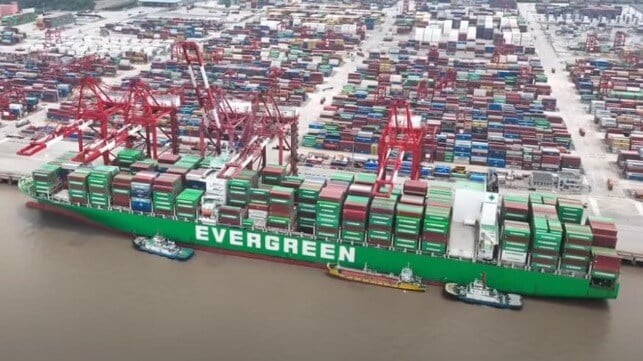Shanghai Demonstrates Ship-to-Ship Transfer for Captured CO2 – The Maritime Executive

Demonstration of Ship-to-Ship CO2 Transfer at Port of Shanghai
Introduction
On June 19, 2024, the Port of Shanghai hosted the first-ever demonstration of a ship-to-ship (STS) transfer of carbon dioxide (CO2) captured from a large Evergreen containership during its operations. This milestone represents a significant advancement in CO2 capture technology for in-service vessels, aligning with global efforts to meet stringent emission regulations and contribute to Sustainable Development Goals (SDGs), particularly SDG 13 (Climate Action) and SDG 9 (Industry, Innovation, and Infrastructure).
Details of the Operation
- Location: Yangshan Deepwater Port’s Shengdong Terminal.
- Vessel: Ever Top, a 152,300 deadweight tonnage (dwt) containership.
- Retrofitting: Completed in 2024 by China State Shipbuilding Corporation (CSSC) with a CO2 capture system designed by Shanghai Marine Diesel Research Institute.
- System Components:
- Absorption module
- Regeneration module
- Compression refrigeration
- Storage facilities onboard
- Performance: Captures over 80% of CO2 emissions with 99.9% purity, storing CO2 onboard until offloading.
Innovations in CO2 Offloading
One of the main challenges in shipboard CO2 capture is the economical and practical offloading and storage of captured CO2. Previously, offloading was conducted via trucks or tanks, which was slower, cumbersome, and geographically limited.
In this demonstration, a barge vessel named De Jin, similar to a bunker barge, was positioned alongside the docked Ever Top for the CO2 transfer. This marked the first ship-to-ship transfer from a CO2 capture system, offering several advantages:
- Greater capacity compared to truck-based offloading
- Increased flexibility in offloading locations
- Reduction of bottlenecks in CO2 transfer logistics
- Significant cost savings compared to land transport
Environmental and Economic Impact
The captured CO2 is intended for reuse in various industrial applications, supporting SDG 12 (Responsible Consumption and Production) by promoting resource efficiency and circular economy principles.
Chinese authorities highlight the potential economic benefits, estimating that vessels could generate up to $8 million annually from the sale of captured CO2. This creates a new revenue stream for shipping companies while contributing to SDG 8 (Decent Work and Economic Growth).
Cost Efficiency and Future Prospects
- Retrofitting the Ever Top cost approximately $10 million, which is substantially less than the expense of building a new vessel or converting to alternative fuels.
- CO2 capture technology offers a practical and economical pathway to extend the service life of existing vessels amid tightening emission regulations.
- This initiative supports SDG 7 (Affordable and Clean Energy) by promoting cleaner maritime operations.
Conclusion
The successful demonstration of ship-to-ship CO2 transfer at the Port of Shanghai represents a critical step forward in maritime decarbonization efforts. By integrating innovative CO2 capture and transfer technologies, the shipping industry can significantly reduce greenhouse gas emissions, promote sustainable industrial practices, and contribute to multiple Sustainable Development Goals.
1. Sustainable Development Goals (SDGs) Addressed or Connected
- SDG 13: Climate Action
- The article focuses on CO2 capture from ships, directly addressing climate change mitigation.
- SDG 9: Industry, Innovation and Infrastructure
- The development and demonstration of ship-to-ship CO2 transfer technology represents innovation in industrial processes and infrastructure.
- SDG 12: Responsible Consumption and Production
- The reuse of captured CO2 in industrial applications promotes sustainable production practices.
- SDG 7: Affordable and Clean Energy
- Retrofitting vessels with CO2 capture systems supports cleaner energy use in maritime transport.
2. Specific Targets Under Those SDGs Identified
- SDG 13 – Target 13.2: Integrate climate change measures into policies and planning.
- The retrofitting of ships with CO2 capture systems aligns with integrating climate action into maritime operations.
- SDG 9 – Target 9.5: Enhance scientific research, upgrade technological capabilities of industrial sectors.
- The development of the CO2 capture system and ship-to-ship transfer technology demonstrates technological advancement.
- SDG 12 – Target 12.5: Substantially reduce waste generation through prevention, reduction, recycling and reuse.
- Reuse of captured CO2 in industrial applications supports waste reduction and resource efficiency.
- SDG 7 – Target 7.a: Enhance international cooperation to facilitate access to clean energy research and technology.
- The retrofit project and technology development indicate progress toward cleaner energy technologies in shipping.
3. Indicators Mentioned or Implied to Measure Progress
- Indicator for SDG 13.2:
- Percentage reduction in CO2 emissions from retrofitted vessels (over 80% capture rate mentioned).
- Indicator for SDG 9.5:
- Number of vessels retrofitted with CO2 capture technology; demonstration of new transfer methods (ship-to-ship CO2 transfer).
- Indicator for SDG 12.5:
- Volume of CO2 captured and reused in industrial applications instead of being emitted.
- Indicator for SDG 7.a:
- Investment amount in clean energy retrofit technologies (e.g., $10 million retrofit cost).
4. Table of SDGs, Targets, and Indicators
| SDGs | Targets | Indicators |
|---|---|---|
| SDG 13: Climate Action | 13.2: Integrate climate change measures into policies and planning | Percentage reduction in CO2 emissions from retrofitted vessels (80% capture rate) |
| SDG 9: Industry, Innovation and Infrastructure | 9.5: Enhance scientific research and upgrade technological capabilities | Number of vessels retrofitted; demonstration of ship-to-ship CO2 transfer technology |
| SDG 12: Responsible Consumption and Production | 12.5: Substantially reduce waste generation through prevention, reduction, recycling and reuse | Volume of CO2 captured and reused in industrial applications |
| SDG 7: Affordable and Clean Energy | 7.a: Enhance international cooperation to facilitate access to clean energy research and technology | Investment amount in clean energy retrofit technologies (e.g., $10 million retrofit cost) |
Source: maritime-executive.com








